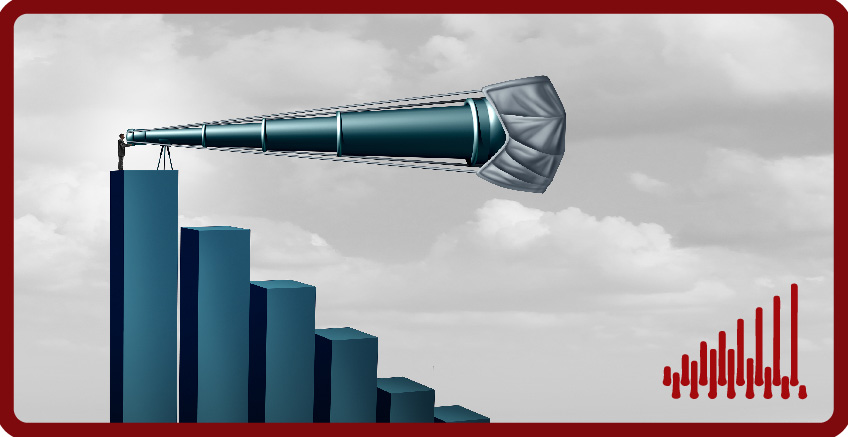Economic forecasting in a time of Covid-19
The economic downturn in the wake of Covid-19 means forecasters must navigate a totally different economic landscape. But by organising thoughts about possible future scenarios, forecasts can help governments identify policies to bridge from today to a new future

The economic downturn in the wake of Covid-19 means forecasters must navigate a totally different economic landscape. But by organising thoughts about possible future scenarios, forecasts can help governments identify policies to bridge from today to a new future.
The Nobel prize-winning physicist Nils Bohr said that “prediction is very difficult, especially if it’s about the future”. The abrupt change to all our personal economic circumstances caused by the Covid-19 virus and the responses to it aimed at saving lives have made Bohr’s quote when applied to economic forecasting sound like an under-statement.
Consider the case of forecasting the likely path of UK output. Over the past half century in the UK the average quarterly change in gross domestic product (GDP) has been 0.6 per cent. In only 10 quarters in the past half century has the quarterly change been greater than 2 per cent, either positive or negative. So, before the recent lockdowns GDP might have been expected to rise or fall by slightly less than 1 per cent in most quarters. As a result, the debate among economic forecasters considering the short-term outlook was invariably about the number after the decimal point. Covid-19 has changed that.
While the last half century has included booms and recessions, there have been few periods of exceptionally severe economic dislocation. The closest recent parallel in the UK to the disturbance to normal economic activity that we are now seeing is probably the Three Day Week in early 1974, when commercial users of electricity were able to use electricity on only three consecutive days in a week. GDP fell by 2.7 per cent in the first quarter of that year, the largest quarterly fall in the past half century. When financial markets froze in 2008 the cumulative fall in GDP was larger than in 1974 but the largest quarterly fall was of 2.1 per cent in the final quarter of that year. But this time the economic dislocation is much more severe.
The closing of many businesses either by direct order or as people stay at home to prevent the spread of the virus, both in the UK and overseas, has affected economic activity severely. In the first quarter of this year GDP fell by 1.2 per cent in the US and by 3.8 per cent in the Euro Area, even though the lockdown measures were only in force for a part of that period. We will find out how far activity fell in the UK in the first quarter on the 12th of May. We at NIESR have pencilled in a fall of around 5 per cent, making it by far the largest quarterly fall in the past half a century.
But the lockdown, which started in late March, has continued through April and looks likely to run through most of May. It is, therefore, likely that economic activity will fall by much more in the second quarter of this year. Looking at information on activity levels in different sectors of the economy, we have estimated that GDP might fall by between 15 and 25 per cent. Such a fall is an order of magnitude greater than anything seen in the last fifty years. Even contemplating such a fall involves considering a totally different economic landscape.
A key point now is that the fall in output is a response to a deliberate policy to save lives, not a response to pressures that have built in the economy. The key immediate policy need is to support people and businesses while they are unable to work normally. Circumstances now are unlike previous periods in the past half century when output fell. Once the health emergency is over and restrictions are lifted, people and businesses will be able to return to work and output will rise. The key issue in forecasting the medium-term outlook is what that return to work will look like.
While economic forecasters have some information for recent activity, in the face of unprecedented events looking further ahead requires considering a more uncertain environment and requires more imagination in the face of a wide range of possible outcomes. The most important considerations concern when and how the lockdown might end and how people and businesses will react to the new circumstances they face. Here, economic scenarios created by forecasts can map out different possibilities based on assumptions that can be tested as the future unfolds.
There are many ‘unknown knowns’ for economic forecasters to consider. We do not know how many businesses that have closed temporarily will be able to spring back, how quickly they will be able to do that and whether they will be able to operate at the same scale. Some businesses will have had to close permanently. We do not know the extent to which the experience of the virus and the lockdown may have changed business and consumer attitudes to undertaking what before the crisis were regarded as normal activity. Even if people can afford to do so, will they still want to go to pubs and restaurants, theatres and cinemas as frequently as before, to commute in to work on crowded trains, or even to buy the latest fashions in the same way as before the experience with Covid-19? What about our holidays – will we still want to fly to exotic places, to take weekend city breaks, or to go on long cruises? With such a range of uncertainties, economic forecasting in such circumstances might appear to be a rather futile task.
While economic forecasts tend to concentrate on presenting single scenarios, they are not, however, an end in themselves. They are a way of organising thoughts about possible futures and enabling debates about what might be done now to make a better tomorrow. Providing a structured idea of what possibilities tomorrow might bring enables economists and policymakers to think about what policies could provide a bridge from today to tomorrow.
All of the unknowns about the outlook suggest that while economic activity will increase after the lockdown restrictions are lifted, it will not rise back rapidly to its pre-Covid-19 level. NIESR’s latest forecast anticipates that it may take 18 months for the UK to recover its output level but, given the nature of the uncertainties, there can be no guarantee of that timing. Even if GDP shows a substantial immediate rebound after the lockdown ends, the forecast points to the need for economic policy to continue to support those whose economic prospects have been blighted by the virus, especially if the resulting increase in unemployment remains stubbornly high as it did after the financial crisis a decade ago.





















